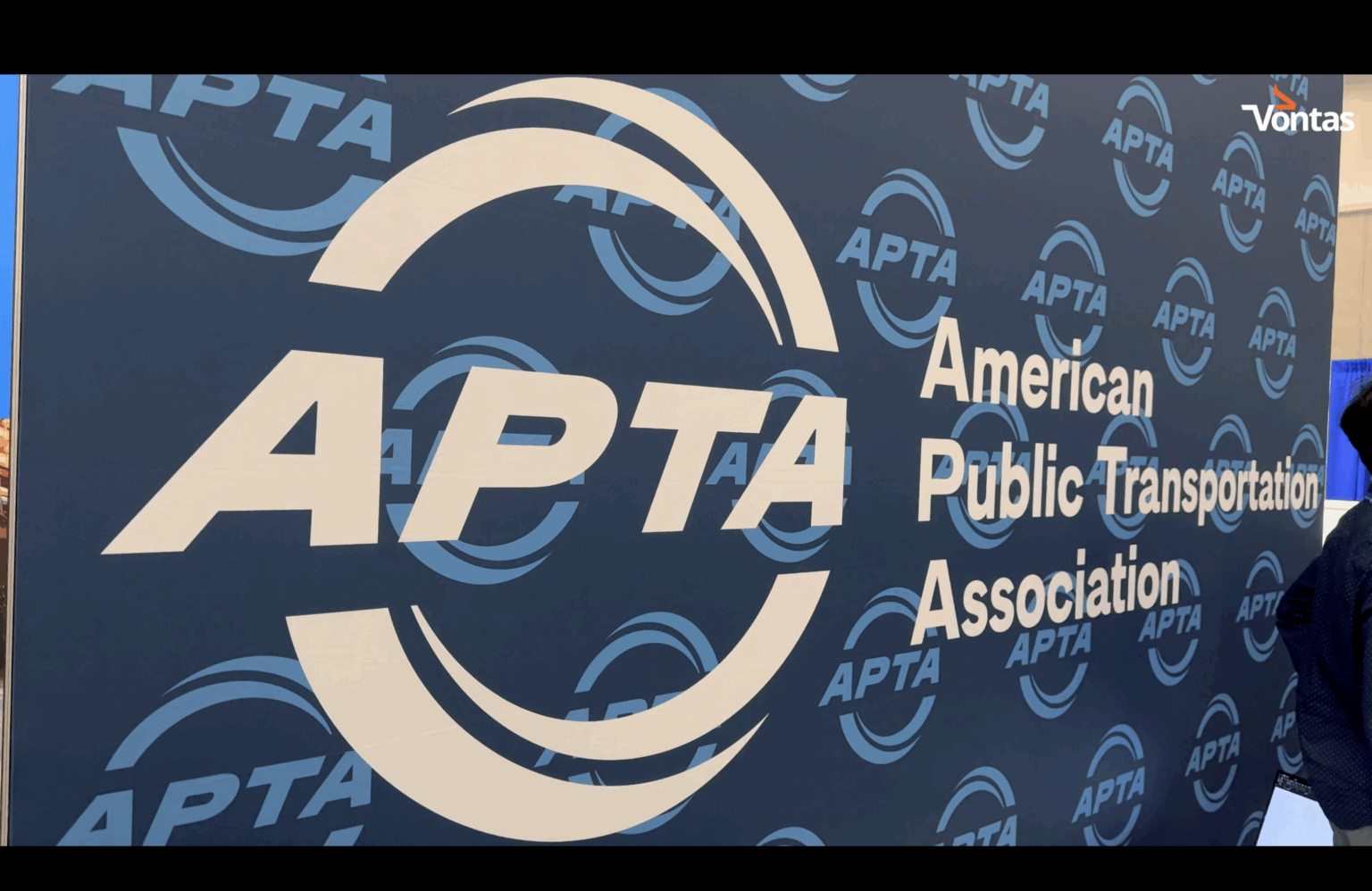

In This Blog
- Public Transit Ridership Surges 17% in 2023, signaling a strong recovery toward pre-pandemic levels and renewed trust in multimodal systems.
- U.S. Transit Service Expands Nationwide, with over 4.5 billion vehicle revenue miles and 6,102 stations enhancing accessibility and rider experience.
- Cleaner, Smarter Fleets Lead the Way, as hybrid and natural gas vehicles rise and 99.8% of buses become wheelchair-accessible.
- Transit Employment Hits 437K+, Salaries Average $83K, reinforcing the sector’s economic impact and need for operational efficiency tools.
- $93.4 Billion in Transit Funding Fuels Innovation, with agencies investing in modernization, safety, and rider-first technologies like Vontas OnRoute and OnTransit.
The APTA Public Transportation Fact Book offers a comprehensive overview of the industry’s current state and its future direction. The 2025 edition reveals continued growth across ridership, service, and investment, signaling that transit’s comeback is here.
For agencies, operators, and partners, these numbers validate what the industry has already been working toward: smarter, safer, and more connected transit systems built for long-term impact. Let’s take a closer look at the latest numbers and what they mean for the future of public transit.
Ridership Is Rising Nearly Back to Pre-Pandemic Levels
In 2023, Americans took 7.04 billion unlinked passenger trips, a 17% increase over 2022. These trips represented a total of 36.6 billion passenger miles, also an increase of 18%. While not quite at 2019 levels, it’s a positive sign that the rebound has been steady and widespread.
Interestingly, bus and rail modes are nearly identical in trip share, with bus accounting for 49% and rail coming in just behind at 48%. This similarity is a sign that multimodal transit systems are thriving, especially when paired with intelligent scheduling and CAD/AVL solutions like Vontas OnRoute, which help agencies manage complex operations in real- time.
Based on these numbers, it’s clear that the riders are back, and expectations are higher than ever. It’s wonderful to see that public transit is being used as a trusted form of transportation again. For agencies to keep up with this rise, they need the right data, visibility, and tools to make every ride count.
Service Expansion Is Picking Up Steam
In 2023, U.S. transit systems delivered over 4.5 billion vehicle revenue miles and logged nearly 304 million revenue hours, indicating how agencies are adapting to meet growing demand. The country now supports 99 rail systems, with 78 newly added since 2003 and 131 system extensions over that time. Transit continues to strive for greater efficiency and faster service, with 18 Bus Rapid Transit (BRT) systems operating on dedicated guideways.
Nationwide, there are now 6,102 transit stations, many of which are undergoing improvements to enhance accessibility, connectivity, and rider experience. From upgraded signage to real-time arrival displays and safety enhancements, agencies are actively building infrastructure that supports modern mobility.
This level of growth requires better coordination and more effective tools. As systems expand and rider expectations evolve, agencies need solutions that can keep up. Platforms like Vontas OnTransit help unify station communications, automate passenger updates, and provide complete visibility across routes and modes. It provides the foundation agencies need to scale confidently while staying focused on what matters most: reliable, rider-first service.
Fleets Are Cleaner, Smarter, and More Accessible
Out of 177,457 vehicles available for service, nearly 130,000 operated at peak capacity, indicating a strong signal of rising operational demand and service coverage.
At the same time, the types of vehicles on the road are shifting:
- Diesel buses dropped to 43% of the fleet
- Natural gas vehicles rose to 28%
- Hybrid electric buses reached 20%
Accessibility has also seen significant improvement, with 99.8% of buses now wheelchair-accessible, supporting more inclusive transit experiences. And electrification is gaining momentum: rail systems consumed 6.2 billion kWh of electricity in 2023, all while improving energy efficiency over time.
Transit agencies are clearly embracing the shift to greener, more accessible systems. And with automation tools and integrated fleet management capabilities, Vontas empowers these agencies to monitor performance, optimize routes, and track fuel and emissions data more effectively.
Transit Employment and Compensation Are Up
The industry supported 437,313 employees last year, 96% of whom work in operations. In 2023, agencies paid out more than $36.4 billion in total compensation, with an average salary of $83,180—reinforcing the vital role transit plays in both urban and rural economies. But beyond headcount, building a resilient workforce requires the right tools, data, and systems to reduce friction in daily operations.
When frontline staff have access to intuitive technology, real-time data, and automated workflows, they can respond faster, communicate more effectively, and serve passengers more efficiently. Vontas solutions help make that possible by supporting the people who keep transit running with tools that simplify decision-making and reduce day-to-day strain.
Safety Continues to Set Transit Apart
In 2023, there were 330 transit-related fatalities compared to 40,901 on U.S. highways. All U.S. commuter rail systems have added another layer of safety to rail operations by implementing Positive Train Control (PTC).
Transit remains one of the safest ways to travel, and technology plays a crucial role in this. From real-time operator alerts to automated incident tracking, Vontas solutions help keep passengers, operators, and systems safe.
Investments are Flowing, but Expectations are Growing
Public transportation funding in the U.S. reached $93.4 billion, a 5.7% increase from the year prior. Of that, $61.5 billion supported operations, and $27.6 billion was allocated toward capital improvements, ranging from fleet modernization to station upgrades. Federal funding accounted for 38% of capital expenditures, while local and direct sources provided 34% of the operating budget.
Fare revenue remained modest at $10.6 billion, with the average fare holding at just $1.50. This fact underscores the delicate balance transit agencies face: delivering better service and expanding access, all while keeping costs low for riders.
With more dollars flowing in and more accountability tied to each of them, agencies need greater transparency into operations, real-time performance insights, and technology that helps stretch funding further. That’s where tools like Vontas OnRoute and OnTransit come in, assisting agencies to do more with their budgets while staying aligned with funding goals and community impact.
Contracting and the Private Sector: A Growing Share
In 2023, 28% of transit services were contracted, particularly in demand-response and vanpool modes. In total, $51 billion was spent through the private sector, accounting for 57% of all transit expenditures.
This statistic shows that agencies are increasingly relying on trusted partners to execute specialized services. With deep experience in public transit and proven solutions like
Vontas OnRoute and OnTransit, Vontas helps ensure those partnerships deliver measurable outcomes.
Progress Is Visible and It’s Just the Beginning
The data from this report tells a clear story that transit is regaining strength, modernizing operations, and setting the pace for cleaner, more connected urban mobility.
This renewed investment and ridership are a signal to keep pushing forward. Whether it’s better CAD/AVL coordination, streamlined passenger communications, or deeper operational visibility, the future of transit demands systems that are as agile as the people who run them. Want to see the complete APTA Public Transportation Fact Book?
